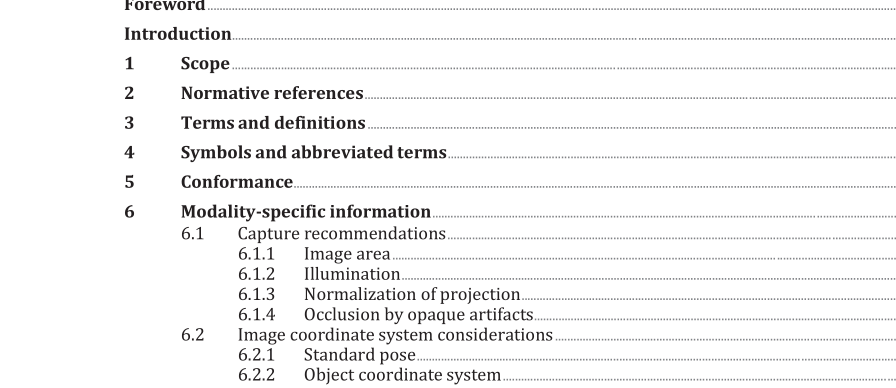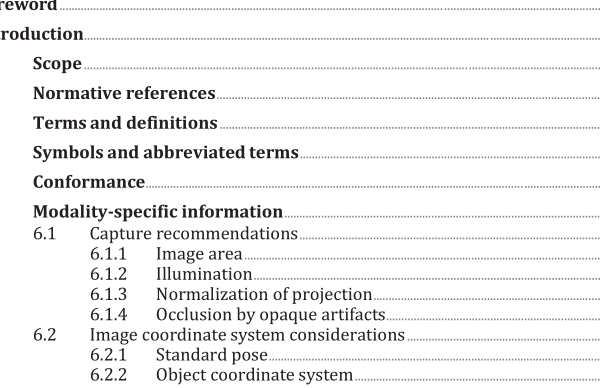ISO IEC 39794-9:2021 pdf download – Information technology — Extensible biometric data interchange formats — Part 9: Vascular image data.
1 Scope This document specifies — generic extensible data interchange formats for the representation of vascular image data: a tagged binary data format based on an extensible specification in ASN.1 and a textual data format based on an XML schema definition that are both capable of holding the same information, — examples of data record contents, — application specific requirements, recommendations, and best practices in data acquisition, and — conformance test assertions and conformance test procedures applicable to this document. 2 Normative references The following documents are referred to in the text in such a way that some or all of their content constitutes requirements of this document. For dated references, only the edition cited applies. For undated references, the latest edition of the referenced document (including any amendments) applies. ISO/IEC 39794-1, Information technology — Extensible biometric data interchange formats — Part 1: Framework ISO/IEC 14495-1, Information technology — Lossless and near-lossless compression of continuous-tone still images: Baseline — Part 1: ISO/IEC 15444-1, Information technology — JPEG 2000 image coding system — Part 1: Core coding system ISO/IEC 15948, Information technology — Computer graphics and image processing — Portable Network Graphics (PNG): Functional specification ISO/IEC 8824-1, Information technology – Abstract Syntax Notation One (ASN.1) – Part 1: Specification of basic notation ISO/IEC 8825-1, Information technology – ASN.1 encoding rules – Part 1: Specification of Basic Encoding Rules (BER), Canonical Encoding Rules (CER), and Distinguished Encoding Rules (DER) 3 Terms and definitions For the purposes of this document, the terms and definitions given in ISO/IEC 39794-1 and the following apply. ISO and IEC maintain terminological databases for use in standardization at the following addresses: — ISO Online browsing platform: available at https://www.iso .org/obp — IEC Electropedia: available at https://www.electropedia .org/
6 Modality-specific information 6.1 Capture recommendations 6.1.1 Image area Vascular pattern biometric technologies obtain images from different locations of the human body. The technologies currently available employ images from the finger, back of the hand, and palm side of the hand. The location used for imaging shall be specified in the format. Also, the direction (left/right) of hand and/or finger index (thumb, index, middle, ring, and little) shall be specified. This document reserves fields for future development of technologies potentially using different parts of the human body. 6.1.2 Illumination For the capture of vascular biometric images, the skin is typically illuminated using NIR wavelengths in the range of approximately 700 to 1 200 nm. The angle from the light source to the tangent plane of the skin’s surface is not defined in VIR because technologies that use a reflectance image may use diffuse illumination instead of direct illumination for the purpose of avoiding specular reflectance. Instead, this document specifies that the image is either based on transparency or reflectance of the observed biometric characteristic. Two or more wavelengths of the illumination light source may be specified in the case that multiple different light sources are used for background masking. 6.1.3 Normalization of projection The captured image shall be an orthographic projection of the body area being imaged. If the original raw image is not orthographic to the body area, it shall be converted to an orthographically projected one. Any major geometric distortion caused by the optical system shall also be eliminated prior to creation of the VIR. 6.1.4 Occlusion by opaque artifacts Some opaque artifacts, such as rings, tattoos, bandages, etc., can occlude vascular patterns. Using images including occlusions should be avoided.
ISO IEC 39794-9:2021 pdf download – Information technology — Extensible biometric data interchange formats — Part 9: Vascular image data






